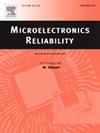Localization enhancement in quantitative thermal lock-in analysis using spatial phase evaluation
IF 1.6
4区 工程技术
Q3 ENGINEERING, ELECTRICAL & ELECTRONIC
引用次数: 0
Abstract
The paper discusses enhancements in quantitative thermal lock-in analysis through spatial phase evaluation for defect localization in complex microelectronic components. It addresses the challenges of increasing integration density and diverse material composition in microelectronics. The primary focus of the present work is placed on improving sensitivity and spatial resolution of lock-in thermography for detection, imaging and the quantitative localization of thermally active electrical defects in all three spatial dimensions inside a device under test (DUT) to enable precise fault isolation. The paper describes the analysis of the lateral phase distribution in the presence of a thermal hot spot for reconstructing the thermal wave at the surface of the DUT and its back-tracing to its source inside the DUT. In the practical application this processing results in a reduction of thermal spreading effects and a precise localization in the lateral and axial (depth) directions. Experimental results demonstrate substantial improvements in precision and accuracy of defect localization and additionally a quantitative depth estimation. The paper highlights the potential application of the proposed method for non-destructive defect localization in 3D-integrated microelectronic devices.
空间相位评价在定量热锁定分析中的定位增强
本文讨论了通过空间相位评估对复杂微电子元件缺陷定位的定量热锁定分析的改进。它解决了在微电子中增加集成密度和多样化材料组成的挑战。目前工作的主要重点是提高锁定热成像的灵敏度和空间分辨率,用于检测、成像和在被测设备(DUT)内所有三个空间维度的热活性电气缺陷的定量定位,以实现精确的故障隔离。本文分析了存在热热点时的横向相位分布,用于重建被测体表面的热波并回溯到被测体内部的热波源。在实际应用中,这种处理可以减少热扩散效应,并在横向和轴向(深度)方向上精确定位。实验结果表明,在缺陷定位的精度和准确性方面有了很大的提高,并且还可以定量地估计深度。本文重点介绍了该方法在三维集成微电子器件中无损缺陷定位的潜在应用。
本文章由计算机程序翻译,如有差异,请以英文原文为准。
求助全文
约1分钟内获得全文
求助全文
来源期刊

Microelectronics Reliability
工程技术-工程:电子与电气
CiteScore
3.30
自引率
12.50%
发文量
342
审稿时长
68 days
期刊介绍:
Microelectronics Reliability, is dedicated to disseminating the latest research results and related information on the reliability of microelectronic devices, circuits and systems, from materials, process and manufacturing, to design, testing and operation. The coverage of the journal includes the following topics: measurement, understanding and analysis; evaluation and prediction; modelling and simulation; methodologies and mitigation. Papers which combine reliability with other important areas of microelectronics engineering, such as design, fabrication, integration, testing, and field operation will also be welcome, and practical papers reporting case studies in the field and specific application domains are particularly encouraged.
Most accepted papers will be published as Research Papers, describing significant advances and completed work. Papers reviewing important developing topics of general interest may be accepted for publication as Review Papers. Urgent communications of a more preliminary nature and short reports on completed practical work of current interest may be considered for publication as Research Notes. All contributions are subject to peer review by leading experts in the field.
 求助内容:
求助内容: 应助结果提醒方式:
应助结果提醒方式:


